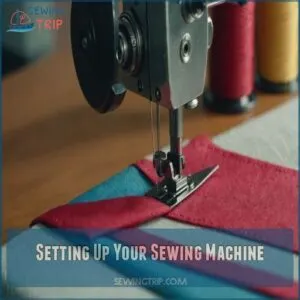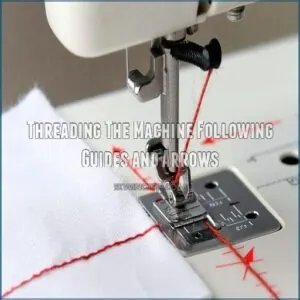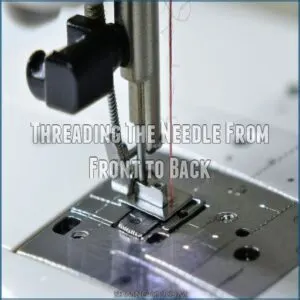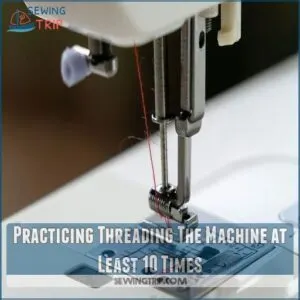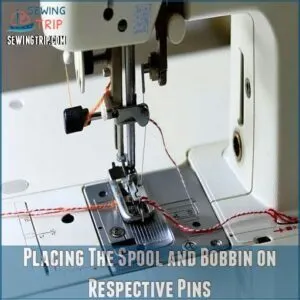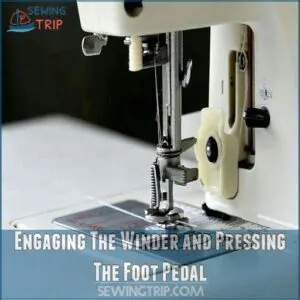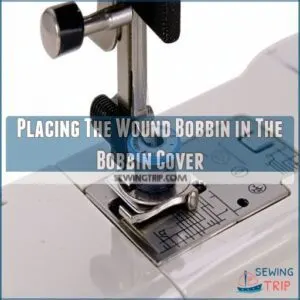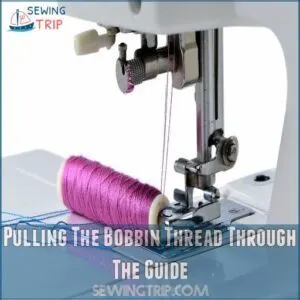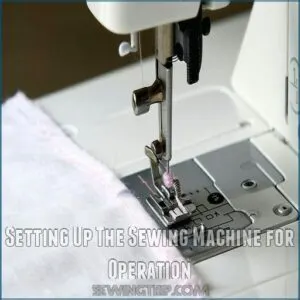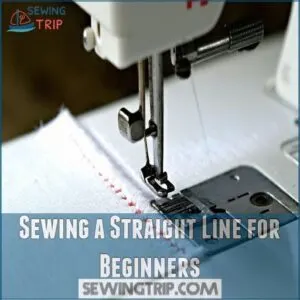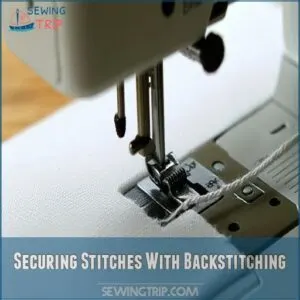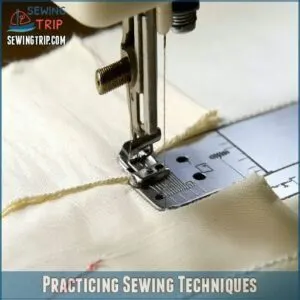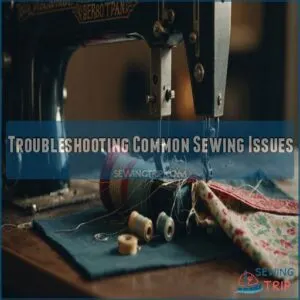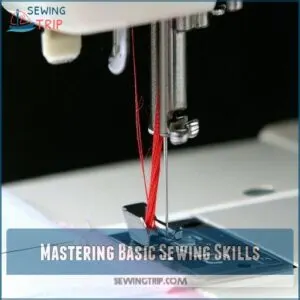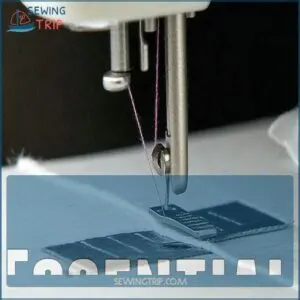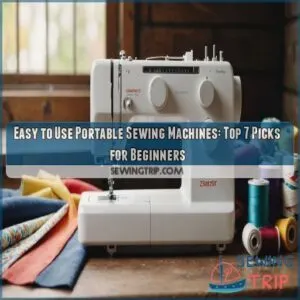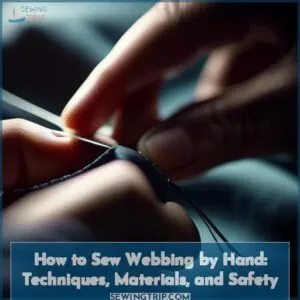This site is supported by our readers. We may earn a commission, at no cost to you, if you purchase through links.
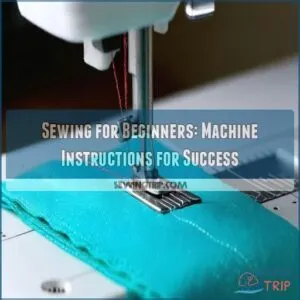 Sewing for beginners machine instructions are easier than you think!
Sewing for beginners machine instructions are easier than you think!
First, you’ll want to thread your machine – follow those arrows; it’s like a fun little maze.
Then, wind your bobbin; it’s the small spool that goes inside.
Next, practice stitching straight lines on scrap fabric.
Don’t worry about mistakes – everyone starts somewhere!
Mastering the basics of sewing for beginners machine instructions is all about practice.
You’ll be surprised how quickly you’ll pick it up.
Once you’ve got the hang of straight lines, try some curves.
We’ll cover more advanced techniques later, including helpful tips to avoid common pitfalls.
Table Of Contents
- Key Takeaways
- Setting Up Your Sewing Machine
- Threading a Sewing Machine for Beginners
- Winding and Loading The Bobbin
- Setting Up The Sewing Machine for Operation
- Sewing a Straight Line for Beginners
- Securing Stitches With Backstitching
- Practicing Sewing Techniques
- Troubleshooting Common Sewing Issues
- Mastering Basic Sewing Skills
- Essential
- Frequently Asked Questions (FAQs)
- Conclusion
Key Takeaways
- You’ll need to set up your machine properly first – place it on a sturdy surface, check the foot pedal and needle, and ensure correct threading following the machine’s guides and arrows.
- You should master the basics of winding and loading the bobbin, coordinating your hand and foot movements, and practicing straight lines on scrap fabric before moving to actual projects.
- You’ll want to secure your stitches by backstitching at the start and end of seams, and remove pins as you sew to prevent damage to your fabric and machine.
- You can troubleshoot common issues by checking thread tension, addressing fabric bunching, and dealing with broken threads – regular practice and joining a sewing community will help you improve faster.
Setting Up Your Sewing Machine
Getting your sewing machine ready is easier than you think!
Let’s get it set up on a sturdy surface.
Check the needle and foot pedal.
Then, we’ll be ready to thread it.
Placing The Machine on a Sturdy Surface
Kick off by setting your sewing machine on a rock-solid table to ensure surface height is right for comfort.
It’s like giving your machine a solid dance floor for balance.
Organize your workspace to keep vibration control in check.
A steady surface makes everything smoother, helping avoid unexpected wobbles and making sure your projects stay on track.
Checking The Foot Pedal and Needle
Now that your machine’s on a sturdy surface, let’s make sure your foot pedal’s in the right spot—comfort is key!
Check your needle type and size, ensuring it’s sharp and aligned straight.
A bent needle’s like a wonky steering wheel, so swap it if needed.
These small tweaks give you a smoother sewing ride!
Verifying The Machine is Threaded Properly
Imagine threading a machine as a weaving a tapestry. Follow these steps:
- Check the thread guide placement—make sure your thread’s path is correct.
- Monitor bobbin tension to avoid snarls.
- Confirm needle threading from front to back.
- Engage the upper feed dog smoothly.
Precision here crafts the perfect foundation for your sewing journey.
Preparing The Fabric
Great job threading your machine!
Before stitching, get your fabric sorted. Use sharp scissors to cut it accurately.
Pin your fabric to keep it steady, preventing slips.
A hot iron’s your best friend—press fabric for smooth sewing.
Don’t forget to mark any sewing lines with chalk.
Different fabric types need different treatment, so adjust accordingly.
Happy sewing!
Threading a Sewing Machine for Beginners
Threading your sewing machine might seem tricky at first, but following the guides and arrows makes it a breeze.
Practice threading the needle from front to back at least ten times to build your confidence and get comfortable with the process.
Threading The Machine Following Guides and Arrows
Got your machine sitting pretty? Let’s tackle threading by following those guides and arrows.
Think of it like tracing a treasure map; the thread guides lead you through the machine’s labyrinth.
With bobbin thread essentials, arrows are your compass—trust them.
If threading feels tricky, picture yourself as a seasoned explorer; mistakes are just part of the adventure.
Troubleshooting errors sharpens your skills, paving the way for smoother stitching.
Threading The Needle From Front to Back
Now that you’ve threaded your machine, it’s time to tackle the needle. This might seem tricky, but it’s simpler than you think! Here’s how to thread a needle from front to back:
- Hold the needle firmly.
- Insert the thread from the front.
- Gently guide the thread through.
- Make sure the thread is secure.
- Pull gently to tighten the thread.
With a little patience, you’ll master this step in no time.
Remember, practice makes perfect!
Practicing Threading The Machine at Least 10 Times
You’ve threaded the needle from front to back, but practice makes perfect, right?
Try threading your machine at least ten times.
It’s like getting to know an old friend—each pass fine-tunes your skills.
This helps with needle alignment and stitch quality, as you familiarize yourself with thread tension and bobbin winding across different sewing machine types.
Winding and Loading The Bobbin
When you’re winding and loading the bobbin, start by placing the thread spool and bobbin on their pins and engaging the winder with a press of the foot pedal.
Carefully place the wound bobbin in its cover and pull the thread through the guide to make sure sewing goes smoothly.
Placing The Spool and Bobbin on Respective Pins
Start by positioning the spool on the spool pin, making sure it’s correctly oriented for efficient thread flow, with right-handed users placing the spool to the left and left-handed users to the right as explained in spool pin orientation basics. From there, the bobbin takes center stage on the bobbin winder pin.
Here’s the plan:
- Check your spool pin’s type for compatibility.
- Use the bobbin winder for smooth winding.
- Make sure the bobbin is placed correctly.
- Maintain good thread tension to avoid tangles.
Mastery lies in the details.
Engaging The Winder and Pressing The Foot Pedal
With your bobbin snugly on the winder, give your foot pedal a gentle press.
Feel like a racing car driver? Adjust the winding speed for control.
Watch as the thread direction flows smoothly.
If bobbin tension seems off, ease back on the foot pedal pressure.
Remember, balance is key—like juggling plates at a circus.
| Step | Action |
|---|---|
| 1 | Position bobbin on the winder |
| 2 | Engage the winder |
| 3 | Control speed with foot pedal pressure |
Placing The Wound Bobbin in The Bobbin Cover
Now it’s time to place that wound bobbin into the bobbin case. Here’s how:
- Open the bobbin cover: Lift the lever to access your bobbin holder.
- Insert the bobbin: Make sure it spins counterclockwise.
- Secure the bobbin: Snap it gently into position.
- Close the cover: Hear a click to confirm it’s locked.
You’ve nailed the bobbin placement!
Pulling The Bobbin Thread Through The Guide
Alright, you’ve wound your bobbin.
Now, confidently pull the bobbin thread through the guide.
Mastering the art of sewing begins with understanding the basics of a sewing machine, such as the various components like the hand wheel and presser foot. Imagine it weaving a path, calming any bobbin thread tension fears.
Make sure the bobbin thread direction is correct.
Check that the guide location aligns perfectly.
Here’s a simple table for troubleshooting:
| Step | Problem Solved | Tip |
|---|---|---|
| Thread pulling | Snags | Check thread tension |
| Correct direction | Misalignment | Align bobbin properly |
| Guide location | Missed guide | Re-thread carefully |
Setting Up The Sewing Machine for Operation
Now you’re ready to get your sewing machine humming! Let’s get it set up for action by adjusting the stitch settings and positioning your fabric.
Setting The Stitch Control to Straight Stitch
To kick off your sewing journey, make sure your machine is set to a straight stitch. This setting is your foundation for neat seams and a professional touch.
Before you get started:
- Locate the stitch control knob or button.
- Set it to straight stitch.
- Check your manual for guidance.
- Prepare for smooth sailing.
- Test on scrap fabric.
Adjusting The Stitch Length and Width
Playing with stitch length and width feels like painting with fabric.
Adjust these dials to match your fabric type—longer stitches for thick fabrics, shorter for delicate pieces.
Think of stitch density as your brushstroke, influencing seam appearance.
Using a sewing machine with adjustable stitch width provides complete control over sewing projects, allowing for delicate seams and bold decorative patterns like these sewing machines.
Like seasoning soup, tweak until it’s right.
Feeling adventurous? Test different settings on scrap fabric to see the magic unfold.
Lifting The Presser Foot Using The Lever
The presser foot lever, usually lurking behind or to the side of your sewing machine, is like your fabric’s guardian angel.
This lever’s function is to lift and lower the foot, releasing pressure when you need to swap fabrics or threads.
With a smooth motion, press the lever up—almost like raising a flag—to lift the foot effortlessly.
Placing The Practice Fabric Under The Presser Foot
Imagine the fabric as your stage, ready to showcase your sewing skills.
Slide it under the presser foot, ensuring the presser foot pressure is just right to avoid puckering.
Align the fabric’s edge for your desired seam allowance.
Check the needle position, feeling the gentle hum of mastering fabric tension as you prepare for smooth, flawless stitches.
Sewing a Straight Line for Beginners
Sewing a straight line might seem tricky at first, but with a little practice, you’ll master it.
Focus on keeping your hands steady, and remember to guide the fabric gently without pulling to help your sewing machine do its best work.
Lowering The Presser Foot and Putting The Needle Down
With the presser foot lifted, place your fabric under it.
Now, gently lower the presser foot using the lever, adjusting the pressure to match your fabric’s thickness.
Time to put the needle down! Turn the handwheel in your direction until the needle dips into the fabric.
Mastering this step is like finding the rhythm in a dance—essential for smooth sewing.
Holding The Upper Thread and Bobbin Thread
Before you start sewing, gently hold both the upper and bobbin threads.
This is important for a smooth start and prevents tangles.
Here’s what to do:
- Keep a loose grip; don’t pull too hard.
- Let the threads hang naturally.
- Make sure there’s no slack or knots.
- A good grip helps with even thread tension and securing stitches.
Starting a seam correctly is half the battle!
Pressing Down on The Foot Pedal to Start Sewing
Now that you’re ready to sew, gently press down on the foot pedal.
Think of it like revving a car engine; ease into it.
You can find a variety of sewing machine start stop options to help you control your machine’s speed.
The greater your foot pedal pressure, the faster it’ll sew.
Adjust your speed for smooth fabric movement and consistent stitching.
You’ll get the knack of starting and stopping with a bit of practice!
Coordinating Hand and Foot to Keep Fabric Moving
You’ve mastered the pedal, and it’s time to create harmony between your hands, fabric, and foot pressure.
Think of it like dancing—your hand speed sets the rhythm, guiding the fabric through with ease.
Keep an eye on fabric tension to make sure a smooth sewing flow.
Practice this rhythm, and soon, your coordination will feel as natural as breathing.
Securing Stitches With Backstitching
To make sure your stitches don’t unravel, use backstitching at the beginning and end of a seam.
Hold the thread tightly, press the reverse button to stitch backwards briefly, then stitch forwards again.
Setting Up Fabric to Begin Sewing
Let’s get that fabric set up right! Whether you’re using cotton, linen, or any other fabric type, lay it flat. Smooth out wrinkles with ironing. Mark the sewing lines with a pencil. Turn to your trusty sewing pins to keep it all in place. Finally, cut the fabric carefully, ensuring each piece aligns perfectly.
- Choose the right fabric type
- Lay fabric flat
- Iron to remove wrinkles
- Mark lines with a pencil
- Secure with sewing pins
Starting to Sew With Thread Held
Grab your threads and get ready to secure your stitches by learning how to backstitch on sewing machine.
Hold the upper thread and bobbin thread snugly in your left hand.
Feel the rhythm as the fabric feeds under the needle, ensuring the stitch length is just right.
Keep an eye on the needle position; don’t lose your cool if the thread tension‘s off.
| Factor | Feeling | Action |
|---|---|---|
| Thread Tension | Frustration | Adjust Dial |
| Fabric Feed | Excitement | Steady Hands |
| Needle Position | Anticipation | Guided Focus |
Pressing The Reverse Button to Stitch Backwards
Backstitching is your secret weapon for securing stitches and preventing unraveling.
Press the reverse button and watch magic happen as your machine sews backward, reinforcing your seam with added strength.
It’s like giving your stitches a safety net, ensuring they hold firm, especially on those important edges.
Remember, short reverse stitch lengths work best to lock in the fabric securely.
Taking The Machine Out of Reverse to Stitch Forward
Once your reverse stitch secures the seam end, gently release the reverse stitch control.
Your machine will smoothly switch back to forward stitching.
For a smooth backstitching experience, explore backstitch sewing machine options at backstitch machines online.
Maintain a consistent pace with the foot pedal.
A steady hand guides the fabric, ensuring a smooth, even seam.
You’ll soon master this; remember, practice makes perfect!
Enjoy the satisfying rhythm of forward stitching.
Practicing Sewing Techniques
Practicing sewing techniques builds essential skills for your sewing journey.
Start by sewing straight lines and curves on practice fabric, using markers to guide you and removing pins as you reach them.
Sewing Straight Lines and Curves on Practice Fabric
Got that fabric choice in mind?
Start by experimenting with stitch lengths to see how they affect your lines, and to achieve a professional finish, consider learning how to sew straight.
For curves, imagine you’re sketching with thread, gently steering the fabric.
Remember, it’s not a race, so take your time. Those practice tips you’ve heard? They’re golden. Each seam, even the wobbly ones, builds your confidence and skill.
Using Markers to Guide Stitching
Markers can be your trusty sidekick for precise stitching.
Create sewing guides with a water-soluble pen or pencil for pattern accuracy.
Here’s the scoop on fabric marking techniques to keep your lines straight:
- Chalk: Easy to remove.
- Water-soluble pen: Wash it out.
- Heat-erasable pen: Vanishes with an iron.
- Tailor’s tacks: Handy for thick fabrics.
- Tracing wheel and paper: Classic choice.
Removing Pins as You Reach Them
Think of yourself as a sewing maestro!
As you guide your fabric, keep an eye on those pins.
Gently remove each one just before it reaches the needle—this stops fabric damage and keeps stitch quality sharp.
It’s like a tiny ballet of precision and timing, ensuring needle safety and maintaining sewing speed.
Mastering pin placement keeps your creations smooth and professional.
Troubleshooting Common Sewing Issues
When your sewing machine decides to play tricks, it’s helpful to know the basics of troubleshooting.
Troubleshooting your sewing machine can help you keep it running smoothly.
From adjusting thread tension and fixing pesky thread bunching to addressing fabric snags and broken threads, you’ll learn how to keep your machine running smoothly.
Checking Thread Tension and Spacing
Tackling thread tension issues is like tuning a musical instrument.
If your stitches are uneven or fabric puckers, check both needle and bobbin tension.
Adjust settings until the fabric flows smoothly without pulling or skipping.
Wrong needle size can also mess up your harmony, so match it with the fabric.
Master tension, and your sewing will sing!
Referring to a Thread Bunching Solution Guide
Why’s your thread bunching up? Don’t panic! Let’s troubleshoot. Here’s what to check:
- Thread tension: Is it too tight? Loosen it slightly.
- Needle: Is it the right size for your fabric? A wrong needle choice often causes problems.
- Bobbin winding: Is your bobbin wound evenly? Uneven winding can create this issue.
A quick adjustment often solves the problem, but if not, there’s more help available online or at your local sewing shop.
Addressing Fabric Getting Sucked Down Into The Machine
You’re ready to sew, but the fabric gets sucked down like it’s in a vortex.
It often stems from needle plate issues or incorrect foot pressure.
Check if the fabric type aligns with your settings.
Adjust bobbin tension, or verify feed dogs aren’t jammed.
It’s like a team effort—the machine, the fabric, and your skilled hands.
Dealing With Broken Thread
Broken threads can be as irritating as a stubborn coffee stain. But don’t fret! It’s often about tension or thread quality, not your skills. Keep these tips in mind:
- Check thread tension settings.
- Use quality threads.
- Make sure the needle isn’t bent or dull.
- Re-thread both top and bobbin threads.
- Clean lint and debris from the machine.
Mastering Basic Sewing Skills
When you’re starting out with sewing, regular practice can make all the difference in mastering those basic skills.
Join a sewing community for tips and support, and soon you’ll be sewing with confidence.
Practicing Regularly to Improve Technique
You may have heard the saying, "practice makes perfect," and it’s especially true when sewing.
Regular practice helps you build muscle memory, making threading the needle or sewing straight lines second nature.
Set aside a few minutes each day for sewing practice to see consistent improvement.
Try tackling small projects or sewing challenges to enhance your skills.
If you make a mistake, don’t fret—errors are stepping stones to mastery.
Over time, these sessions will improve your accuracy and make you more comfortable handling fabric, ultimately leading to greater satisfaction with your sewing projects.
Joining a Sewing Community for Support and Feedback
Getting a hang of sewing through regular practice? Fantastic! Now, consider joining a sewing community to truly enhance your skills. You can learn so much by engaging with others who share your passion, and many online platforms offer free trials, like Skillshare’s free sewing classes.
Here are a few things to explore:
- Online sewing groups: Connect with fellow beginners and experts.
- Local sewing classes: Hands-on learning with teachers and peers.
- Finding sewing mentors: Guidance from those with more experience.
- Sharing sewing projects: Show off your work and get inspired.
- Asking for critiques: Receive helpful feedback to improve.
Communities make your sewing journey more rewarding!
Essential
Stitching success starts with knowing the essentials. Here’s a quick guide:
| Essential | Description |
|---|---|
| Needles | Pick the right needle for your fabric type. |
| Thread | Choose threads that suit your fabric’s tension. |
| Pins | Use fabric pins to secure patterns. |
| Seam Ripper | Handy for undoing mistakes quickly. |
Your sewing journey feels like mastering a new dance, each step bringing you closer to creative freedom. With these must-haves, you’re ready to sew with confidence every time.
Frequently Asked Questions (FAQs)
Can a beginner use a sewing machine?
Imagine your creative potential emerging as you guide fabric under the needle.
Yes, to get started, you can find beginner-friendly guidance on setting up the machine to ensure proper maintenance and preparation. A beginner can absolutely use a sewing machine!
With patience and practice, you’ll confidently stitch your way to crafting wonders.
How do I learn to sew on a sewing machine?
Start by familiarizing yourself with your sewing machine’s manual; it’s like your sewing encyclopedia.
Practice threading, loading the bobbin, and stitching on scrap fabric.
Watch online tutorials for visual guidance, and don’t rush—slow and steady wins!
How do you set up a sewing machine?
Set your sewing machine on a sturdy surface, with needle on the left.
Securely plug in the foot pedal, thread the machine, and position the bobbin.
Adjust stitch settings, and begin stitching smoothly toward sewing success!
How to start a sewing project for a beginner?
Kick off your sewing project by choosing a simple pattern, like a tote bag.
Gather your fabric and supplies, follow step-by-step instructions, and don’t stress mistakes; they’re part of learning.
Enjoy every stitch!
What do you need to start sewing for beginners?
Sewing is like painting with fabric.
You need a sewing machine, fabric, thread, needles, scissors, and pins.
Add some patterns and a measuring tape, and you’re set!
Think of these as your artist’s toolbox.
How to start sewing?
First, gather your supplies!
Then, choose a simple project.
Start slow, practice makes perfect.
Don’t be afraid to ask for help – everyone starts somewhere!
You’ll be stitching up a storm in no time.
How to use a sewing machine for the first time?
Position your sewing machine on a sturdy table, plug in the foot pedal, and thread the needle and bobbin.
Select your stitch length, place fabric, and start stitching.
Remember, practice makes perfect!
Enjoy sewing your first project.
How do you sew step by step for beginners?
Start by setting up your machine carefully.
Choose the right needle, thread the machine, and fill the bobbin.
Place fabric under the needle, lower the presser foot, and gently press the pedal to begin sewing.
Can I teach myself to use a sewing machine?
Absolutely, you can teach yourself to use a sewing machine!
Start small with simple projects.
Practice regularly.
Don’t hesitate to make mistakes.
Online tutorials and guides offer plenty of support as you master each step.
How does a sewing machine work step by step?
Lift the presser foot, place fabric under the needle, and lower the foot.
Press the foot pedal gently to start stitching.
Guide fabric evenly.
Use the reverse button to secure seams.
Adjust settings for fabric type.
How do I change the sewing machine foot?
Changing your sewing machine foot isn’t rocket science!
Simply disengage the presser foot lever, slide the current foot away, and align the new foot under the shank.
Snap it securely, and you’re set to start stitching!
What should I do if my needle breaks?
When your needle breaks, switch off your machine and remove the broken pieces.
Install a new needle, ensuring it’s seated correctly.
Check for tension issues or improper fabric positioning.
Resume sewing with caution and check your settings.
How do I adjust thread tension?
Imagine this: perfectly even stitches!
Adjusting the thread tension properly is key to preventing issues like thread bunching, which can be resolved by following these tips for troubleshooting sewing issues. Your sewing machine’s thread tension dial controls how tight or loose those stitches are.
Tweak it – a tiny turn makes a big difference.
Experiment until you find that sweet spot!
How do I clean a sewing machine properly?
Unplug your machine and remove the needle and presser foot.
Use a small brush to dust the bobbin case and feed dogs.
Apply sewing machine oil to the recommended spots.
Reassemble and wipe the exterior clean.
What fabrics are easiest for beginners?
Jump into sewing with ease by choosing forgiving fabrics like cotton, fleece, and felt.
They’re like your loyal sidekicks—easy to handle, don’t slip around, and won’t leave you tangled in complexity as you practice.
Conclusion
Starting your sewing journey might feel like climbing Mount Everest with a needle, but you’ve got this!
With these sewing for beginners machine instructions as your guide, you’re well-equipped to tackle any project that comes your way.
Remember, every expert seamstress started exactly where you’re now.
Take it one stitch at a time, practice regularly, and don’t be afraid to make mistakes.
Before you know it, you’ll be creating beautiful pieces and wondering why you ever thought it was difficult.

